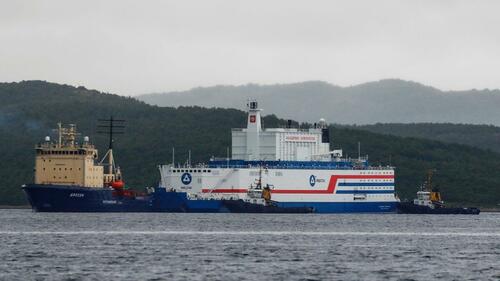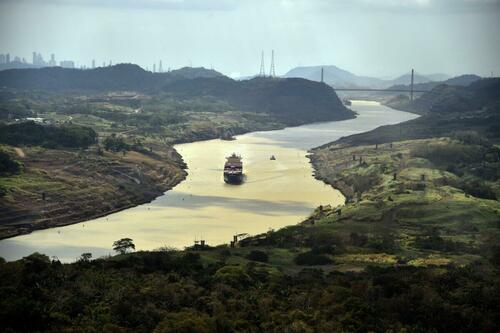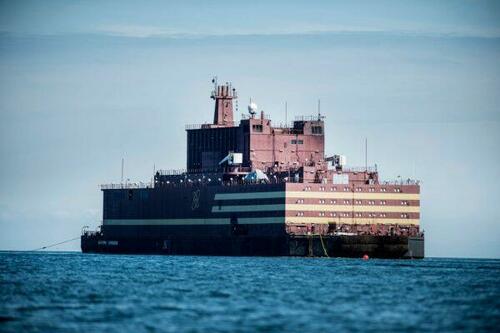Russia Building Floating Nuclear Reactor Fleet To Power Remote Projects
Authored by Katie Spence via The Epoch Times,
China’s Wilson Heavy Industry shipyard held a keel-laying ceremony in August for the first of four barges that’ll eventually employ not one but two nuclear reactors.
Once completed, the barge will become Russia’s second floating nuclear power plant.
The first, the Akademic Lomonosov, was commissioned in 2020 and was the world’s first floating nuclear power plant since the 1960s. It’s also currently the only floating atomic reactor and a key component in Russia’s plan to open a significant shipping lane through the Arctic.
But a shipping lane is only the beginning of Russian president Vladimir Putin’s plan for floating nuclear power plants. Last year, Rosatom, a Russian state nuclear energy corporation, presented Putin with a reported $2.3 billion proposal to build up to five floating nuclear reactors.
Along with opening a Northern Sea Route, Russia’s easternmost province is home to a copper and gold mine that’s said to be the world’s largest unexploited deposit. The area has no roads and little power, necessitating a creative power source.
A view shows Russia’s floating nuclear power plant Akademik Lomonosov and tugboat Dixon before the departure from the service base of Rosatomflot company for a journey along the Northern Sea Route to Chukotka in Murmansk, Russia, on Aug. 23, 2019. (Maxim Shemetov/Reuters)
Nuclear Fuels Expansion
In the 1960s, the U.S. Army Corps of Engineers converted a former World War II Liberty Ship into the first floating nuclear power plant. Containing a single-loop pressurized water reactor, the MH-1A STURGIS generated electricity in the Panama Canal at a time when building a new energy plant wasn’t cost-effective or feasible.
While the STURGIS proved practical and reliable for supplying power to an onshore grid for military and civilian use, the Army Corps shut it down in 1976 after the Panama Canal Company installed permanent power supplies in the area. From 1976 to Russia’s latest endeavors, no floating nuclear power plants were built or proposed, according to the American Nuclear Society.
In 2020, Russia finished building and launched its first floating nuclear power plant in Pevek, a remote and sparsely populated Russian port off the northern coast of Siberia. Pevek is a strategic location for Putin’s expansion plans because he views it as a future central shipping hub and because Pevek is close to Chukotka, an area rich in copper, lithium, gold, and silver.
A merchant ship sails along the Panama Canal on March 23, 2015. (Rodrigo Arangua/AFP via Getty Images)
In 2019, Putin stated at the International Arctic Forum in St. Petersburg, “[Artic expansion] is a realistic, well-calculated, and concrete task. We need to make the Northern sea route safe and commercially feasible,” RadioFreeEurope reported.
Currently, Pevek’s harbor is only accessible for four months a year. Still, Putin believes a changing climate will eventually enable a Northern Sea route and an economically viable North-East passage between Russia and the West, the Arctic Institute reports.
More importantly, Putin isn’t alone in his belief. The United States, Norway, Denmark, and Canada also believe in a Northern Sea route future and have realized the need to compete for jurisdiction in the area.
In 2017, then-U.S. defense secretary Jim Mattis said of Russia’s Arctic expansion, “The Arctic is key strategic terrain. Russia is taking aggressive steps to increase its presence there. I will prioritize the development of an integrated strategy for the Arctic.”
Floating Nuclear Power
Chukotka is the farthest northeastern portion of Siberia and is said to be where the world’s day begins. It also borders Alaska by the sea and is heavily populated with reindeer. Reindeer herding is the main focus of agriculture in the region, which is something Putin hopes to change with his Arctic mining venture.
Located within Chukotka is Baimskaya, a mining project, which the company in charge of the project, Kaz Minerals, reports has “the world’s most significant undeveloped copper assets with the potential to become a large scale, low cost, open pit copper mine.” The deposit was discovered in 1972 but remained undeveloped due to a lack of infrastructure and roads. Russia is using its floating nuclear power plants to address part of the problem.
The Academic Lomonosov won’t reach full ramp-up until 2023, and even then, it won’t be enough to supply all the necessary power for Putin’s Arctic expansion plan in Chukotka. Consequently, Russia commissioned four more floating nuclear power plants.
The Academy Lomonosov passes by the island of Langeland, off the coast of Spodsbjerg in Denmark, on May 4, 2018. (Tim Kildeborg Jensen/AFP/Getty Images)
“The required infrastructure is being processed with the Russian government in accordance with the Complex Development Plan for the Chukotka region. … Carbon-free power will be supplied to the site from a nuclear facility to be constructed and operated by Rosatom, enabling the Group to produce very low-carbon copper,” Kaz Minerals reports.
It adds, “The project is located in a region identified by the Russian Government as strategically important for economic development and is expected to benefit from the provision of tax incentives.”
According to the World Nuclear Organization, the Baimskaya development requires approximately 300 megawatts of electricity. Rosatom plans to provide the power via its scheduled three floating nuclear power plants. Each ship will have a pair of pressurized water nuclear reactors designed to produce 55 megawatts of electricity. The fourth ship will be held in reserve and used for emergencies and repairs.
Realizing the potential for Arctic expansion made possible through floating nuclear power plants, Danish start-up Seaborg Technologies is developing a Seaborg Power Barge. The development was made possible by a grant from the European Union.
Tyler Durden
Wed, 10/12/2022 – 02:00
via ZeroHedge News https://ift.tt/w3eZDzR Tyler Durden


